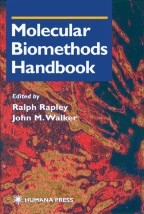Mobility Shift Assays

The electrophoretic mobility shift assay (EMSA, also known as the gelshlft, gel retardation, or bandshift assay) is a technique that is widely used to study interactions between proteins and nucleic acids The assay is simple to perform, because it requires little specialized equipment and only small quantities of the protein to be studied, yet it can yield detailed informatlon about the binding speclficlty of a protein, the kinetics of the binding reaction, and the structural consequences of the protein- DNA interaction Unlike other techniques, such as nitrocellulose filter binding assays, EMSA can also be used to gain informatlon about the stoichiometry of protein- DNA complexes and to study interactlons between proteins within a multlprotein- DNA complex
This is a preview of subscription content, log in via an institution to check access.
Access this chapter
Subscribe and save
Springer+ Basic
€32.70 /Month
- Get 10 units per month
- Download Article/Chapter or eBook
- 1 Unit = 1 Article or 1 Chapter
- Cancel anytime
Buy Now
Price includes VAT (France)
eBook EUR 76.99 Price includes VAT (France)
Tax calculation will be finalised at checkout
Purchases are for personal use only
Similar content being viewed by others

Shift-Western Blotting: Separate Analysis of Protein and DNA from Protein–DNA Complexes
Chapter © 2015

Analysis of DNA-Protein Interactions Using PAGE: Band-Shift Assays
Chapter © 2013

Gel-Based Analysis of Protein–Nucleic Acid Interactions
Chapter © 2021
References
- Fried, M. G. and Liu, G. (1994) Molecular sequestration stabilizes CAP-DNA complexes during polyacrylamide gel electrophoresis. Nucleic Acids Res. 22,5054–5059. ArticlePubMedCASGoogle Scholar
- Dahlberg, A. E., Dingman, C. W., and Peacock, A. C. (1969) Electrophoretic characterizatio of bacterial polyribosomes in agarose-acrylamide composite gels. J. Mol. Biol.41,139–147. ArticlePubMedCASGoogle Scholar
- Spassky, A., Busby, S. J. W., Danchin, A., and But, H. (1979) On the binding of tRNA to E. coli RNA polymerase. Eur. J. Biochem. 99, 187–201. ArticlePubMedCASGoogle Scholar
- Fried, M. and Crothers, D. M. (1981) Equilibria and kinetics of lac repressor-operator interactions by polyacrylamide gel electrophoresis. Nucleic Acids Res. 9,6505–6525. ArticlePubMedCASGoogle Scholar
- Gamer, M. M. and Revzin, A. (1981) A gel electrophoresis method for quantifying the binding of proteins to specific DNA regions: application to components of the Escherichia coli lactose operon regulatory system. Nucleic Acids Res. 9,3047–3600. ArticleGoogle Scholar
- Kolb, A., Busby, S., Herbert, M., Kotlarz, D., and But, H. (1983) Comparison of the binding sites for the Escherichia coli CAMP receptor protein at the lactose and galactose promoters. EMBO J. 2,217–222. PubMedCASGoogle Scholar
- Kolb, A., Spassky, A., Chapon, C., Blazy, B., and But, H. (1983) On the different binding affinities of CRP at the lac, gal and malT promoter regions. Nucleic Acids Res. 11,7833–7852. ArticlePubMedCASGoogle Scholar
- Shaw, P. E. and Stewart, A. F. (1994) Identification of protei*DNA contacts with dimethyl sulfate, in Methods in Molecular Biology, vol. 30: DNA-Protein Interactions: Principles and Protocols (Kneale, G. G., ed.), Humana, Totowa, NJ, pp. 79–87. Google Scholar
- Minchin, S. and Busby, S. (1993) Location of close contacts between Escherichia coli RNA polymerase and guanine residues at promoters with or without consensus-35 region sequences. Biochem. J. 289,771–775. PubMedCASGoogle Scholar
- Tuerk, C. and Gold, L. (1990) Systematic evolution of ligands by exponential enrichment:RNA ligands to bacteriophage T4 DNA polymerase. Science249,505–510. ArticlePubMedCASGoogle Scholar
- He, Y, Stockley, P G, and Gold, L (1996) In vitro evolution of the DNA bmding sites of the Escherzchza co11 methlomne repressor, Met J J MOE Blol255,55–66 CASGoogle Scholar
- Adler, V and Kraft, A S (1995) Regulation of AP-3 enhancer activity during hematopoletic dlfferentlatlon J Cell Physzol164,26–34 ArticleCASGoogle Scholar
- Read, M L, Smith, S B, and Docherty, K (1995) The insulin enhancer bmding site 2 (IEB2, FAR) box of the msuhn gene regulatory region binds at least three factors that can be dlstingulshed by their DNA bmding characteristics Bzochem J309, 231–236 CASGoogle Scholar
- Frted, M G (1989) Measurement of protein-DNA mteractlon parameters by electrophoresls moblhty shift assay Electrophoreszs10,366–376 ArticleGoogle Scholar
- Gerstle, J T and Fried, M G (1993) Measurement of bmding kmetlcs using the gel electrophoresls moblllty shift assay Electrophoreszs14, 725–731 ArticleCASGoogle Scholar
- Gaston, K, Kolb, A, and Busby, S (1989) Bmding of the Escherzchza colz cychc AMP receptor protein to DNA fragments contaming consensus nucleotlde sequences Bzochem J261,649–653 CASGoogle Scholar
- Honkoshl, M, Bertuccloh, C, Takada, R, Wang, J, Yamamoto, T, and Roeder, R G (1992) Transcriptton factor TFIID induces DNA bending upon bmding to the TATA elementProc Natl Acad Scz USA89,1060–1064 ArticleGoogle Scholar
- Wu, H-M and Crothers, D in (1984) The locus of sequence-dlrected and proteminduced DNA bending Nature308,509–513 ArticlePubMedCASGoogle Scholar
- Kim, J, Zwleb, C, Wu, C, and Adhya, S (1989) Bending of DNA by gene-regulatory proteins construction and use of a DNA bending vector Gene85, 15–23 ArticlePubMedCASGoogle Scholar
- Thompson, J F and Landy, A (1988) Empirical estimation of protein-Induced bending angles apphcatlons to h site-specific recombmatlon complexes Nuclezc Aczds Res16,9687–9705 ArticleCASGoogle Scholar
- Zmkel, S S and Crothers, D in (1987) DNA bend dlrectlon by phase sensltlve detectlonNature328, 171–181 Google Scholar
- Knstle, T in and Rolzman, B (1986) a4, the major regulatory protem of herpes simplex virus type 1, is stably and specIfically associated with promoter-regulatory domains of a genes and of selected other viral genes Proc Natl Acad Scz USA83, 3218–3222 ArticleGoogle Scholar
- Lane, D, Prentkl, P, and Chandler, M (1992) Use of gel retardation to analyze protemnucleic acid mteractlons Mcrobzol Rev56, 509–528 CASGoogle Scholar
Author information
Authors and Affiliations
- School of Biochemistry, University of Birmingham, Birmingham, UK Nigel J. Savery & Stephen J. W. Busby
- Nigel J. Savery

